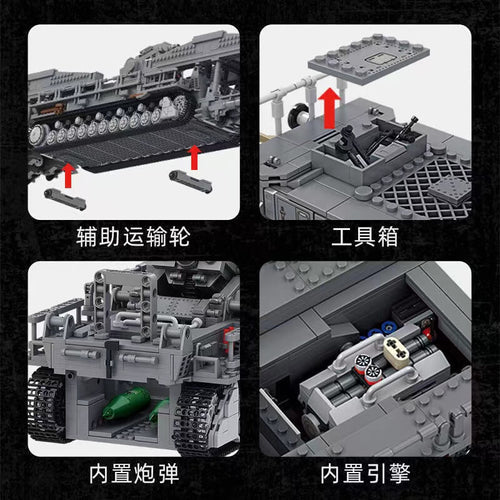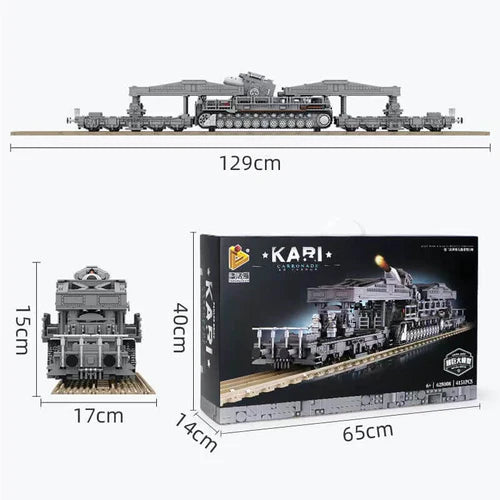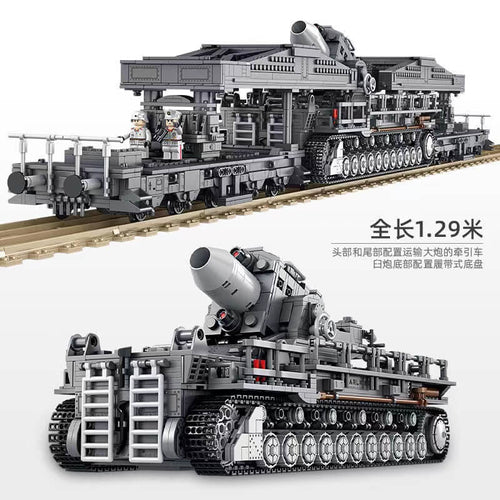Panlos
Panlos Karl Gerat Railway Mortar P628008
- Regular price
- $196.99 CAD
- Regular price
-
- Sale price
- $196.99 CAD
- Unit price
- per
Couldn't load pickup availability
Germany started the super cannon plan in 1933, first to create an 800mm train heavy gun (the famous Gustav cannon), and then in 1937 to design and manufacture a tracked self-propelled heavy mortar-" Karl Mortar".
PANLOS 628008 not only contains the main structure of the Karl mortar, but also the rail transportation system,
The mortar can be separated from the rail transportation chassis and includes 8 minifigures.
Pieces: 4158pcs
Size:129 × 15 × 17 cm
"Karl-Gerät" (040/041) (German literally "Karl-device"), also known as Mörser Karl, was a World War II German self-propelled siege mortar (Mörser) designed and built by Rheinmetall. Its heaviest munition was a 60 cm (24 in) diameter, 2,170 kg (4,780 lb) shell, and the range for its lightest shell of 1,250 kg (2,760 lb) was just over 10 km (6.2 mi). Each gun had to be accompanied by a crane, a two-piece heavy transport set of railcars, and several modified tanks to carry shells.
Seven guns were built, six of which saw combat between 1941 and 1945. It was used in attacking the Soviet fortresses of Brest-Litovsk and Sevastopol, bombarded Polish resistance fighters in Warsaw, participated in the Battle of the Bulge, and was used to try to destroy the Ludendorff Bridge during the Battle of Remagen. One Karl-Gerät has survived and the remainder were scrapped after the war.
The 124-ton vehicle was propelled by a Daimler-Benz MB 503A 12-cylinder liquid-cooled gasoline engine or a Daimler-Benz MB 507C 12-cylinder liquid-cooled diesel engine, but this was mainly used for aiming (the mount had only 4 degrees of traverse on each side), as the engines provided a top speed of only 10 km/h (6.2 mph). For longer distances the Karl-Gerät was disassembled using a special 35 ton mobile crane into seven loads. The chassis was loaded onto a six-axle Culemeyer-Strassenroller lowboy trailer. The other parts of the gun were lighter and used four-axle trailers. If the trailer with the chassis on board had to cross a bridge that couldn't carry their combined weight the chassis had to be off-loaded and driven across under its own power.
The weapon was moved long distances via rail on a variant of a Schnabel car; the whole chassis was hung between two huge pedestal-mounted swiveling arms fixed to five-axle bogies. When it reached its destination, the weapon was detached from railcars' supporting arms and driven to its intended firing location. The chassis of the ordnance was then lowered to the ground by "raising" the continuous track units' roadwheels by rotating their torsion-bar-sprung suspension arms to drop the chassis close to the ground to distribute the recoil forces more evenly in preparation for firing - the roadwheels for each trackset were also similarly "raised" to allow the tracks to clear the rails while being transported by rail, between the pair of Schnabel railcars. The Karl-Gerät proved to have no problems moving over normal soil, but under no circumstances was it allowed to make turns on soft soil lest it throw a track. The chassis had to be backed into position to fire, which expedited movement to a new position, but the land to be used for the ordnance's firing position had to be precisely leveled and the approach route prepared ahead of time to fill in soft spots and any ditches, etc. The mortar itself could only be loaded at zero elevation, so it had to be re-aimed between every shot. (From Wikipedia)
Share













